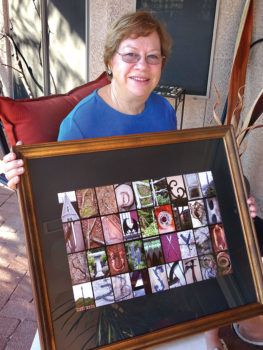
Barbara Wilder displays her Maine: A to Z and 0 to 9 photo collage.
LaVerne Kyriss
“Curiosity is a valuable asset to an artist. You just never know what you’ll turn up.” These words sum up how Barbara Wilder has approached art during a half-century exploring a variety of media and forms. She began exploring her creative side as a young wife, taking painting lessons. “I studied color theory, life drawings and various approaches. I found out I really was drawn to the use of color and abstract art.”
“Later on, I created collages and assemblages. I still am drawn to those and love making them—but I’m resisting my collecting urge to keep all kinds of materials on hand needed to make them,” she explained. “I remind myself that we’re trying to simplify now that we’re in retirement.”
At one point, she took up pottery and ended up with a 35-year career owning a professional pottery studio, selling her wares at art shows all across the nation and wholesale to galleries. “I really just wanted to do individual, unique, one-of-a-kind pieces, but when the auto industry tanked and my husband lost his job, he joined me in the studio and it became a full-time business,” Wilder said. “My favorite glazing style was to use colors in abstract ways.”
When Barbara and her husband Roddy retired and moved to a 55-plus community in Texas, she took up photography. “I enjoy finding color and abstract patterns in nature. Reflections in water, patterns in rock strata, smoke curls, rust patterns and macro photography can all make interesting photographs. It’s all in how the photographer sees it, captures the image and sometimes enhances it with various darkroom or digital editing techniques.
“I believe abstract works should have some impact on the viewer because they express a mood or emotion. Abstract photographs don’t represent the subject in a literal way, but communicate primarily through form, color and curves, rather than image detail,” Wilder explained. “The end result can be a very powerful image. The subject doesn’t have to be recognizable in the same way that a landscape or portrait is expected to be. Abstracts can be created anywhere—-in mud cracks, unfocused blurs or lichens on a rock.
“What’s most important is for the photographer to search out the details and that often requires seeing in a different way. Use your imagination and keep your eyes open,” she encouraged.
“It’s important to me to do something creative every day and I also want to be outdoors at least some of every day. Usually I carry a camera with me everywhere. I try to make at least one picture a day suitable for my year in photo album,” Wilder said. “I grab a shot during my morning walk or a trip to the car wash. I like to experiment by zooming in with the camera, changing the depth of field or shutter speed to blur a moving subject.”
She documented a recent trip by creating an A to Z and 0 to 9 photo collage. Her challenge was to find the letters and numbers in natural or man-made objects. Two purple flower stalked formed the letter V and a vertically hung bicycle provided the loops in the number eight. “It’s all about how you see the world around you,” she smiled. “This project kept me looking throughout the entire trip for interesting shapes and colors.”
